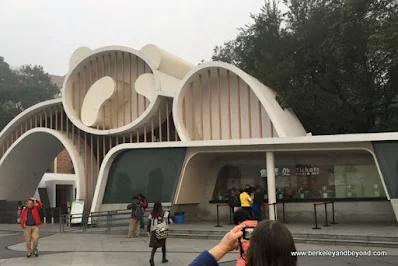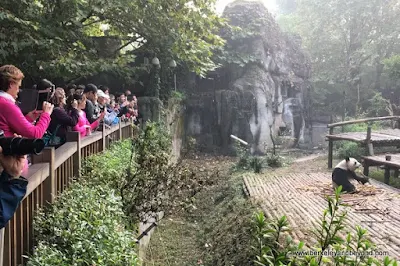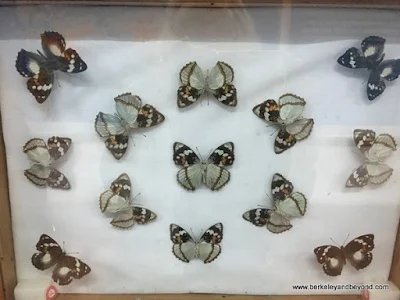Chengdu Research Base of Giant Panda Breeding
1375 Panda Rd., just outside of town, 028-83510033. Daily 7:30am-6pm. 58yuen/US$8/person; parking 10yuen.
Pandas are solitary animals and their remote habitat in bamboo forests high in the Szechwan mountains has been destroyed. Operated by panda conservation specialists, the immaculate zoo-like Chengdu Research Base of Giant Panda Breeding center displays pandas in a near-perfect replication of their natural habitat, including rivers, lakes, wild bamboo forests, and plant pits. Founded in 1987 with just six pandas, it is now home to approximately 50 pandas and has earned a reputation as the best place in the world to see, interact with, and learn about these endangered animals.
It has the largest captive collection of Giant Pandas in the world. Babies are born between July and September. Today, fewer than 2,000 pandas are found in the wild and only approximately 300 are in zoos and breeding centers. Fortunately, China’s giant panda population was recently downgraded from endangered to vulnerable. Though still at risk, their numbers in the wild continue to grow.
Red pandas (or Lesser Pandas) have enclosures here, too, but are also allowed to freely roam the center’s forest floor. This is the largest collection of captive-born red pandas in the world.
Begin a visit here by taking a shuttle to the top, then walk down, visiting the various exhibits as you go. Take time to map out your plan. There is a nursery, kitchen, and hospital, but each is not always open. People do get a little crazy to see the babies, and you might have to elbow your way into a viewing spot. Be patient.
I enjoyed visiting Swan Lake, where there is a population of black swans and hungry koi to feed, and where the outdoor Bamboo Restaurant dispenses simple inexpensive pleasures such as noodles and ice cream and provides umbrella-sheltered communal picnic tables. The Rose Garden Restaurant is more formal and surrounded by a large rose garden.
A museum near the entrance includes an exhibit of China’s butterflies that is in dire need of refreshing.
My favorite souvenir was a pandemonium (the group noun for pandas) of tiny unstuffed soft pandas with magnets in their paws--perfect for hanging together or separately--perhaps from a refrigerator or on the top of a computer (that’s where mine reclines). Note that in the U.S., pandas are housed at zoos in Atlanta, Memphis, San Diego, and Washington, D.C.
More panda videos:
pandas eating bamboo
pandas doing what pandas do best
Pandas are solitary animals and their remote habitat in bamboo forests high in the Szechwan mountains has been destroyed. Operated by panda conservation specialists, the immaculate zoo-like Chengdu Research Base of Giant Panda Breeding center displays pandas in a near-perfect replication of their natural habitat, including rivers, lakes, wild bamboo forests, and plant pits. Founded in 1987 with just six pandas, it is now home to approximately 50 pandas and has earned a reputation as the best place in the world to see, interact with, and learn about these endangered animals.
 |
| entry gate to Chengdu Research Base of Giant Panda Breeding in Chengdu, China |
 |
| bamboo-lined road at Chengdu Research Base of Giant Panda Breeding in Chengdu, China |
It has the largest captive collection of Giant Pandas in the world. Babies are born between July and September. Today, fewer than 2,000 pandas are found in the wild and only approximately 300 are in zoos and breeding centers. Fortunately, China’s giant panda population was recently downgraded from endangered to vulnerable. Though still at risk, their numbers in the wild continue to grow.
 |
| people watch pandas at Chengdu Research Base of Giant Panda Breeding in Chengdu, China |
Red pandas (or Lesser Pandas) have enclosures here, too, but are also allowed to freely roam the center’s forest floor. This is the largest collection of captive-born red pandas in the world.
 |
| children watch red pandas at Chengdu Research Base of Giant Panda Breeding in Chengdu, China |
Begin a visit here by taking a shuttle to the top, then walk down, visiting the various exhibits as you go. Take time to map out your plan. There is a nursery, kitchen, and hospital, but each is not always open. People do get a little crazy to see the babies, and you might have to elbow your way into a viewing spot. Be patient.
I enjoyed visiting Swan Lake, where there is a population of black swans and hungry koi to feed, and where the outdoor Bamboo Restaurant dispenses simple inexpensive pleasures such as noodles and ice cream and provides umbrella-sheltered communal picnic tables. The Rose Garden Restaurant is more formal and surrounded by a large rose garden.
 |
| Swan Lake at Chengdu Research Base of Giant Panda Breeding in Chengdu, China |
A museum near the entrance includes an exhibit of China’s butterflies that is in dire need of refreshing.
 |
| butterfly exhibit at Chengdu Research Base of Giant Panda Breeding in Chengdu, China |
My favorite souvenir was a pandemonium (the group noun for pandas) of tiny unstuffed soft pandas with magnets in their paws--perfect for hanging together or separately--perhaps from a refrigerator or on the top of a computer (that’s where mine reclines). Note that in the U.S., pandas are housed at zoos in Atlanta, Memphis, San Diego, and Washington, D.C.
 |
| panda souvenir from Chengdu Research Base of Giant Panda Breeding in Chengdu, China |
More panda videos:
pandas eating bamboo
pandas doing what pandas do best
More things to do in Chengdu.
Best souvenirs of China.
images and videos ©2017 Carole Terwilliger Meyers





I'm glad to see that the pandas are being kept in conditions similar to their natural habitat, and that their numbers are gradually increasing.
ReplyDeleteWhat a wonderful effort to save the pandas! You travel to the most interesting places.
ReplyDeleteLook who's talking!
DeleteThe Chengdu research base looks like great fun to visit: those baby pandas (cubs?) are so cute! I'd find it hard to read myself away, I'd imagine.
ReplyDeleteHowever my day went, you just fixed it by sharing the pile of baby pandas.
ReplyDeleteThx for this peek at the panda facility in Chengdu, Carole. We had pandas in Winnipeg for awhile quite a number of years ago, and it was fascinating to watch them.
ReplyDeleteDo you know the color of Panda tail ?
ReplyDeleteFind the answer in article Fat Big Pandas of Chengdu in http://stenote.blogspot.com/2017/08/
See also a video in Youtube: https://youtu.be/Djy2N4Zn4lE